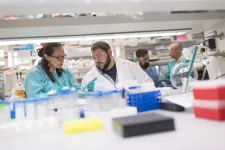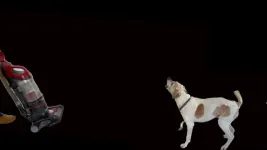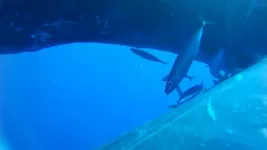EMBARGOED: NOT FOR RELEASE UNTIL 11:00 US ET on MONDAY, MAR. 10, 2025
CONTACT: John Maufort, jpmaufort@wisc.edu
Scientists create a universal vascular graft with stem cells to improve surgery for cardiovascular disease
MADISON — Scientists at the Wisconsin National Primate Research Center (WNPRC) and the Morgridge Institute for Research at the University of Wisconsin–Madison have been at the forefront of stem cell research and regenerative biology since James Thomson isolated the first human embryonic stem cell in 1998.
The Thomson Lab continued to pioneer new techniques to advance the field, including methods to generate functional arterial cells derived from human pluripotent stem cells — opening the door for bioengineered solutions to combat cardiovascular disease.
In a new study published in Cell Reports Medicine, they built upon that work to create a universal, small diameter, vascular graft using stem cell-derived arterial endothelial cells (AECs) that could advance the field of vascular bypass surgery.
“Although synthetic vascular grafts have been successfully used in clinics for large vessel repair, sources for small-diameter vessels, most commonly used for the coronary bypass surgery, are limited,” says senior co-author Igor Slukvin, UW–Madison professor of pathology and laboratory medicine at the WNPRC. “This work is an important step in advancing stem cell technologies for bioengineering vascular grafts for cardiac vessel repair and their clinical translation.”
Currently, the only clinically approved option for small diameter vascular bypass graft involves taking a blood vessel from another part of the patient’s body. However, this method is invasive and limited by which vessels can be used. The graft may also be of poor quality if the patient has comorbidities. Blood vessels taken from another donor are an alternative but are limited by immune responses that lead to graft rejection.
Previous clinical trials engineered venous synthetic vascular grafts for use in peripheral vascular bypass by harvesting patient specific venous endothelial cells with success.
“Patient specific cell therapies can be cost prohibitive and time consuming. We wanted to develop a “off-the-shelf” small diameter arterial graft that can be readily used in clinical settings,” says senior co-author John Maufort, an associate scientist formerly in the Thomson Lab at the Morgridge Institute.
In this study, scientists used a small graft made of ePTFE, a porous material made from the same material as Teflon. Once they generated quality stem cell-derived AECs, they established methods to line them onto the ePTFE grafts.
“The advantages of using pluripotent stem cells are the ability to self-renew, providing an unlimited cell source, and differentiate into any human cell type,” says Maufort.
However, the researchers faced a challenge — ePTFE is hydrophobic and repels water, so they needed to find a way to modify the surface of the grafts so the cells could attach.
“We were inspired by adhesive proteins made in mussels, specifically dopamine, a chemical component of these proteins,” says first author Jue Zhang, one of the corresponding authors of the study and former associate scientist in the Thomson Lab who developed this procedure.
They used a dual-layer coating with dopamine and vitronectin, another cell adhesion protein, to attach the AECs to the inner surface of the ePTFE grafts. They tested them against physiological flow generated by a pump and demonstrated the bioengineered cells remained uniform and stable.
Next, they implanted the grafts into the femoral arteries of Rhesus macaques, a common non-human primate model used for their similarities to human biology. The success of any transplant depends on cells expressing the major histocompatibility complex (both MHC class I and class II) — a group of proteins involved with the immune response to reject a foreign body.
Using this model, the authors experimented with different graft compositions — naked ePTFE grafts, grafts lined with AECs expressing MHC (wildtype), or grafts lined with AECs lacking MHC (double knockout) — to assess immune rejection.
The grafts were monitored biweekly by ultrasound imaging to look for signs of failure, specifically stenosis, cell wall thickening, or thrombosis, a blood clot in the graft. To the researchers’ surprise, 50% of the MHC double knockout grafts failed.
“Since knockout of the MHC class I and II mitigates T-cell response, we hypothesize that natural killer cells could be playing a role in mediating immune rejection of these grafts,” says Zhang.
The MHC wildtype grafts on the other hand, maintained normal function for 6 months, more successful than the other grafts. The authors also observed the graft endothelium was repopulated with the host cells, contributing to long-term success. Their findings suggest that these bioengineered grafts could advance the field of vascular bypass surgery and open possibilities for human clinical trials.
“This is an exciting, collaborative project with the potential to be a true bench to bedside advancement,” says Samuel Poore, chair of the division of plastic surgery at UW–Madison and co-author on the study.
He adds: “Stem cell-based, off-the-shelf vascular grafts, have the potential to expand surgical indications, limit morbidity of operations, and give options for surgery that currently don’t exist, impacting subspecialities such as plastic and reconstructive surgery, vascular and cardiac surgery.”
This work was supported by National Heart, Lung, and Blood Institute grant U01HL134655 and the Office of the Director, National Institutes of Health, under award number P51OD011106.
###
— Jennifer Bal, jennifer.bal@primate.wisc.edu and Mariel Mohns, mmohns@morgridge.org
As an independent research organization, the Morgridge Institute for Research explores uncharted scientific territory to discover tomorrow’s cures. In affiliation with the University of Wisconsin-Madison, we support researchers who take a fearless approach to advancing human health in emerging fields such as regenerative biology, metabolism, virology and medical engineering. Through public programming, we work to inspire scientific curiosity in everyday life. Learn more at: www.morgridge.org
END






